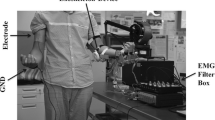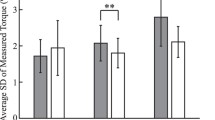Abstract
The purpose of the present study was to determine how joint stiffness during cyclic movement in a vertical plane is modulated at lower or higher frequencies than the natural frequency of the system. Five male subjects were instructed to swing their forearms rhythmically in a vertical plane under various frequency conditions (0.7–2.25 Hz). To estimate the mechanical properties of the elbow joint, external perturbations were applied by an electromagnetic torque motor system to the forearm of each subject during the movement. Joint stiffness showed a significant quadratic trend with a minimum close to the natural frequency of the apparatus–forearm system (1.09±0.08 Hz). The resonant frequency showed the similar tendencies to joint stiffness and was significantly different from movement frequency in the lower frequency range (0.7–0.9 Hz). In addition, the ratio of joint stiffness to the background torque (STratio) was greater in the frequency conditions below the natural frequency than in the frequency conditions above the natural frequency and was relatively constant in the latter. These results suggested that: (1) the modulation of joint stiffness for movement in a vertical plane, by which the resonant frequency of the system is kept close to the movement frequency, may be limited to the movement frequency range above the natural frequency; and (2), in the case of movement in a vertical plane, the mechanism by which joint stiffness is modulated may change according to the relation between natural frequency and movement frequency.


Similar content being viewed by others
References
Akazawa K, Milner TE, Stein RB (1983) Modulation of reflex EMG and stiffness in response to stretch of human finger muscle. J Neurophysiol 49:16–27
Burdet E, Osu R, Franklin DW, Milner TE, Kawato M (2001) The central nervous system stabilizes unstable dynamics by learning optimal impedance. Nature 414:446–449
Bennett DJ (1990) The control of human arm movement: models and mechanical constraints. PhD thesis, MIT, Department of Brain and Cognitive Science
Bennett DJ (1993a) Electromyographic responses to constant position errors imposed during voluntary elbow joint movement in human. Exp Brain Res 95:499–508
Bennett DJ (1993b) Torques generated at the human elbow joint in response to constant position errors imposed during voluntary movements. Exp Brain Res 95:488–498
Bennett DJ (1994) Stretch reflex responses in the human elbow joint during a voluntary movement. J Physiol (Lond) 474:339–351
Bennett DJ, Hollerbach JM, Xu Y, Hunter IW (1992) Time-varying stiffness of human elbow joint during cyclic voluntary movement. Exp Brain Res 88:433–442
Bernstein NA (1967) The co-ordination and regulation of movements. Pergamon , New York
Chandler RF, Clauser CE, McConville JT, Reynolds HM, Young JW (1975) Investigation of inertial properties of the human body. Aerospace Medical Research Laboratory Technical Report. Wright-Patterson Air Force Base, Ohio, pp 74–137
Feldman AG (1980) Superposition of motor programs-I. Rhythmic forearm movements in man. Neuroscience 5:81–90
Gomi H, Kawato M (1997) Human arm stiffness and equilibrium-point trajectory during multi-joint movement. Biol Cybern 76:163–171
Goodman L, Riley MA, Mitra S, Turvey MT (2000) Advantages of rhythmic movements at resonance: minimal active degrees of freedom, minimal noise, and maximal predictability. J Mot Behav 32:3–8
Hatsopoulos NG (1996) Coupling the neural and physical dynamics in rhythmic movements. Neural Comput 8:567–581
Hatsopoulos NG, Warren WH Jr (1996) Resonance tuning in rhythmic arm movement. J Mot Behav 28:3–14
Holt KG, Hamill J, Andres RO (1990) The force-driven harmonic oscillator as a model for human locomotion. Hum Mov Sci 9:55–68
Holt KG, Hamill J, Andres RO (1991) Predicting the minimal energy costs of human walking. Med Sci Sports Exerc 23:491–498
Holt KG, Jeng SF, Ratcliffe R, Hamill J (1995) Energetic cost and stability during human walking at the preferred stride frequency. J Mot Behav 27:164–178
Holt KG, Obusek JP, Fonseca ST (1996) Constraints on disordered locomotion: a dynamical systems perspective on spastic cerebral palsy. Hum Mov Sci 15:177–202
Hunter IW, Kearney RE (1982) Dynamics of human ankle stiffness: variation with mean ankle torque. J Biomech 15:747–752
Konczak J, Brommann K, Kalveram KT (1999) Identification of time-varying stiffness, damping, and equilibrium position in human forearm movements. Mot Control 3:394–413
Kugler PN, Turvey MT (1987) Information, natural law and the self assembly of rhythmic movement. Erlbaum, Hillside, NJ
Lacquaniti F, Licata F, Soechting JF (1982) The mechanical behavior of the human forearm in response to transient perturbation. Biol Cybern 44:35–46
Lacquaniti F, Carrozzo M, Borghese NA (1993) Time-varying mechanical behavior of multijointed arm in man. J Neurophysiol 69:1443–1464
Latash ML (1992) Virtual trajectories, joint stiffness, and changes in the limb natural frequency during single-joint oscillatory movements. Neuroscience 49:209–220
Latash ML, Gottlieb GL (1991) Reconstruction of shifting elbow joint compliant characteristics during fast and slow movements. Neuroscience 43:697–712
Latash ML, Zatsiorsky VM (1993) Joint stiffness: myth or reality? Hum Mov Sci 12:653–692
Mackay WA, Crammond DJ, Kwan HC, Murphy JT (1986) Measurements of human forearm viscoelasticity. J Biomech 19:231–238
Mah CD (2001) Spatial and temporal modulation of joint stiffness during multijoint movement. Exp Brain Res 136:492–506
Milner TE (1993) Dependence of elbow viscoelastic behavior on speed and loading in voluntary movements. Exp Brain Res 93:177–180
Obusek JP, Holt KG, Rosenstein RM (1995) The hybrid mass-spring pendulum model of human leg swinging: stiffness in the control of cycle period. Biol Cybern 73:139–147
Turvey MT, Schmidt RC, Rosenblum LD, Kugler PN (1988) On the time allometry of co-ordinated rhythmic movements. J Theor Biol 130:285–325
Xu Y, Hunter LW, Hollerbach JM, Bennett DJ (1991) An airjet actuator system for identification of the human arm joint mechanical properties. IEEE Trans Biomed Eng 38:1111–1122
Acknowledgements
This study was supported by a grant from the Ministry of Education, Science, Sports and Culture, Japan [Grant-in-Aid for Scientific Research C2 (project No.13680010)]. We would like to thank Dr. Kimitaka Nakazawa for his comments.
Author information
Authors and Affiliations
Corresponding author
Rights and permissions
About this article
Cite this article
Abe, M.O., Yamada, N. Modulation of elbow joint stiffness in a vertical plane during cyclic movement at lower or higher frequencies than natural frequency. Exp Brain Res 153, 394–399 (2003). https://doi.org/10.1007/s00221-003-1583-5
Received:
Accepted:
Published:
Issue Date:
DOI: https://doi.org/10.1007/s00221-003-1583-5




